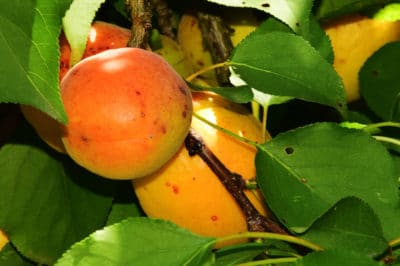Problems with Apricot Tree Leaves
Apricots and other fruit trees are deciduous, losing all of their leaves in late fall and remaining bare through the winter. So, if your tree is losing leaves at the end of the season, don’t worry, but if it happens at other times of the year, something is wrong with the health of the tree.
The most common problems affecting the health of apricot trees often show themselves in the condition of the leaves. These problems include:
- Insufficient water causes wilting and loss of leaves.
- Incorrect fertilizing results in yellowing or other discoloration of leaves.
- Shot hole disease creates holes in leaves and then causes them to drop from the tree.
- Spider mites spin fine webs on the leaves which then turn yellow and fall off.
- Hot weather can burn leaves causing them to turn yellow and fall.
Problems with the health of the tree can also affect the color and shape of the leaves, as well as causing leaves to fall off of the tree.
Preventing Problems with Apricot Trees Leaves
Apricot trees grow in areas with moderate winters and summer temperatures. Select apricot varieties best suited to your climate zone to prevent sunburn and other problems.
Stone fruits like apricots need deep watering about every 10 days to two weeks during late spring and summer months in order to produce ripe fruit and to stay healthy. Be sure trees are regularly getting watered to a soil depth of 18 to 24 inches (45 to 60cm).
Many fungal problems affecting apricot trees can be prevented with the use of dormant oil spray applied to the trees in the winter. Wait until leaves have fallen, but apply the spray before winter rains using Bordeaux mixture, but do not use sulfur sprays on apricot trees.
Dusty conditions encourage spider mites, so keep dust down by planting grass near the trees and keeping it watered during hot months.
Prune and fertilize your trees carefully each year. Apply a balanced fertilizer around the base of the tree each spring, containing nitrogen, potassium, and phosphorus. Prune the tree to remove branches and allow light to reach the center and to keep fruiting wood healthy.
